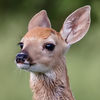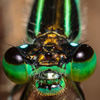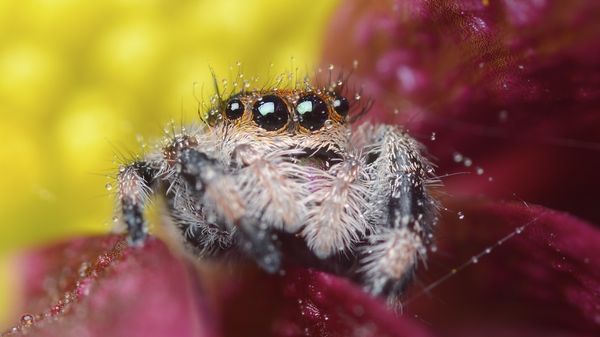Advantage cropped or full frame sensor for macro??
Mar 12, 2014 20:40:35 #
I took a ruler and took 2 shots with a 100mm macro at 1:1, the first with the lens on a cropped sensor (Rebel T3i) and the other on a full frame (Canon 6D).
I then added 68mm of extension tubes to the lens and took two additional shots, again one each with the aforementioned cameras. By shooting the ruler I could reasonably measure the area of the frame in each image, enabling a comparison between a 1:1 cropped sensor and a 1:1 full frame. I found this interesting, and wonder if there are implications for macro shooting.
Below is the results table. I multiplied the width of each frame times .6666, which would give the height of the frame shooting at a 3:2 aspect ratio. Then I multiplied the width times the height to get the total area of the frame in each image, and lastly divided the area by the maximum number of megapixels each camera is capable of in order to get the number of megapixels per square centimeter in each of the images (The T3i can shoot 18mp and the 6D 20.2mp). In both cases the count of megapixels per square centimeter for the T3i was more than twice that of the 6D. I dont actually understand megapixels, but I am wondering if the implication is that shooting macro with a cropped sensor may actually be an advantage since more megapixels are concentrated in a smaller area? Or is this all apples to oranges and there are other considerations?
I then added 68mm of extension tubes to the lens and took two additional shots, again one each with the aforementioned cameras. By shooting the ruler I could reasonably measure the area of the frame in each image, enabling a comparison between a 1:1 cropped sensor and a 1:1 full frame. I found this interesting, and wonder if there are implications for macro shooting.
Below is the results table. I multiplied the width of each frame times .6666, which would give the height of the frame shooting at a 3:2 aspect ratio. Then I multiplied the width times the height to get the total area of the frame in each image, and lastly divided the area by the maximum number of megapixels each camera is capable of in order to get the number of megapixels per square centimeter in each of the images (The T3i can shoot 18mp and the 6D 20.2mp). In both cases the count of megapixels per square centimeter for the T3i was more than twice that of the 6D. I dont actually understand megapixels, but I am wondering if the implication is that shooting macro with a cropped sensor may actually be an advantage since more megapixels are concentrated in a smaller area? Or is this all apples to oranges and there are other considerations?

Mar 12, 2014 20:51:01 #
First note: Your math is a bit off.
I am going to assume that ALL images were at Minimum Focusing Distance. If not, then any comparison is for naught.
In your first chart, the Rebel T3i with lens alone at MFD is 6Mp/cm2;
In your second chart, the Rebel + 67-mm tubes at MFD is 21.18 Mp/cm2.
I originally wrote: Higher magnification (adding tubes) means fewer pixels see the image, not more. But this is wrong.
The MegaPixel count of a sensor does not change, no matter the magnification projected by a lens.
I am going to assume that ALL images were at Minimum Focusing Distance. If not, then any comparison is for naught.
In your first chart, the Rebel T3i with lens alone at MFD is 6Mp/cm2;
In your second chart, the Rebel + 67-mm tubes at MFD is 21.18 Mp/cm2.
I originally wrote: Higher magnification (adding tubes) means fewer pixels see the image, not more. But this is wrong.
The MegaPixel count of a sensor does not change, no matter the magnification projected by a lens.
Mar 12, 2014 21:07:47 #
Nikonian72 wrote:
The lens was in manual focus and set to 1:1, so I moved the lens into focus assuring MFD for all shots.First note: Your math is a bit off.
I am going to assume that ALL images were at Minimum Focusing Distance. If not, then any comparison is for naught.
In your first chart, the Rebel T3i with lens alone at MFD is 6Mp/cm2;
In your second chart, the Rebel + 67-mm tubes at MFD is 21.18 Mp/cm2.
Higher magnification (adding tubes) means fewer pixels see the image, not more.
I am going to assume that ALL images were at Minimum Focusing Distance. If not, then any comparison is for naught.
In your first chart, the Rebel T3i with lens alone at MFD is 6Mp/cm2;
In your second chart, the Rebel + 67-mm tubes at MFD is 21.18 Mp/cm2.
Higher magnification (adding tubes) means fewer pixels see the image, not more.
I am puzzled by "Higher magnification (adding tubes) means fewer pixels see the image, not more." The assumption in my thinking is that whatever megapixels are available are applied to whatever you are seeing in the viewfinder. Apparently this is not so?
Mar 12, 2014 22:57:44 #
nikonian72: i would like to state liamrowans question in a slightly different way:
given a FF macro lens and the 36mpx D800 FF and a 24mpx D7100 DX, which body would you use to shoot your macros?
given a FF macro lens and the 36mpx D800 FF and a 24mpx D7100 DX, which body would you use to shoot your macros?
Mar 13, 2014 01:25:30 #
LiamRowan wrote:
A big factor is noise, smaller pixels - more noise. Newer APC-S sensors handle noise better but aren't as clean as current FF. 6D is going to outperform the T3i in this respect. It will be most noticeable in the background and darker regions of the subject. Test it out for yourself, shoot the same subject, same settings, with both cameras and start increasing the ISO. On well illuminated subjects, you will start noticing differences around ISO 400. In darker regions, noise can pop up at ISO 200. Noise equates to muddled resolution which means less detail.I dont actually understand megapixels, but I am wondering if the implication is that shooting macro with a cropped sensor may actually be an advantage since more megapixels are concentrated in a smaller area? Or is this all apples to oranges and there are other considerations?
Mar 13, 2014 01:32:01 #
LiamRowan wrote:
I originally wrote: Higher magnification (adding tubes) means fewer pixels see the image, not more. But this is wrong. I am puzzled by "Higher magnification (adding tubes) means fewer pixels see the image, not more." The assumption in my thinking is that whatever megapixels are available are applied to whatever you are seeing in the viewfinder. Apparently this is not so?
The MegaPixel count of a sensor does not change, no matter the magnification projected by a lens.
Mp per cm2 of sensor, is the same with lens only, or lens + tubes. (Last line of both charts).
Mar 13, 2014 01:48:08 #
oldtigger wrote:
I use a Nikkor 105G, which will capture 1:1 magnification on either FF sensor or APS-C size sensor. nikonian72: i would like to state liamrowans question in a slightly different way:
given a FF macro lens and the 36mpx D800 FF and a 24mpx D7100 DX, which body would you use to shoot your macros?
given a FF macro lens and the 36mpx D800 FF and a 24mpx D7100 DX, which body would you use to shoot your macros?
I have only used my 105G on APS-C sensor cameras, so I personally cannot compare.
Mar 13, 2014 02:56:57 #
Nikonian72 wrote:
I'm sure glad you cleared that up. Your original post had me scratching my head.:?I originally wrote: Higher magnification (adding tubes) means fewer pixels see the image, not more. But this is wrong.
The MegaPixel count of a sensor does not change, no matter the magnification projected by a lens.
Mp per cm2 of sensor, is the same with lens only, or lens + tubes. (Last line of both charts).
The MegaPixel count of a sensor does not change, no matter the magnification projected by a lens.
Mp per cm2 of sensor, is the same with lens only, or lens + tubes. (Last line of both charts).
Mar 13, 2014 06:35:54 #
A-PeeR wrote:
My current success rate at macro photography is 1/100. The odds of a good shot from two cameras for comparison would therefore be 1/100 x 100 or 1/10,000, so it looks like I won't be conducting that research. HAHA! I suppose I could find an inanimate object and then put the cameras on a tripod. I'll give that a try when the weather turns and I can shoot outside.Test it out for yourself, shoot the same subject, same settings, with both cameras and start increasing the ISO.
Mar 13, 2014 06:41:42 #
LiamRowan wrote:
Just run the test on a tabletop. Much easier to control all the variables. It is a good way to test and learn concepts.My current success rate at macro photography is 1/100. The odds of a good shot from two cameras for comparison would therefore be 1/100 x 100 or 1/10,000, so it looks like I won't be conducting that research. HAHA! I suppose I could find an inanimate object and then put the cameras on a tripod. I'll give that a try when the weather turns and I can shoot outside.
Mar 13, 2014 07:59:27 #
Nikonian72 wrote:
Same here. I use a Nikkor 105G, which will capture 1:1 magnification on either FF sensor or APS-C size sensor.
I have only used my 105G on APS-C sensor cameras, so I personally cannot compare.
I have only used my 105G on APS-C sensor cameras, so I personally cannot compare.
The 1:1 image on FF would not crop as much of the image as would the APS-C sized sensor. The other advantage would be the 36 v. 24 megapixels on a D800 compared to a D7100, for example.
But I can't compare side by side as I have no access to an FX body. Rental rates are more than I want to spend.
Mar 13, 2014 23:52:10 #
LoneRangeFinder wrote:
This is a valid point and advantage of a FF camera. The ability to capture larger subjects at 1:1. Try fitting a decent sized Damsel length wise on a crop, ain't goin' happen. FF it will fit tip-to-tip. Another advantage of the added real estate is the ability to better compose the picture in post with cropping. You have more background to work with. I realize you should try to compose in the viewfinder but there are times when you are tracking an insect and getting the shot in focus takes too much of your attention that composition is lost in the frenzy. There are also instances where ambient light looks better at angles that don't always present the best background throughout the frame but can be remedied with a PP crop. Same here.
The 1:1 image on FF would not crop as much of the image as would the APS-C sized sensor.
The 1:1 image on FF would not crop as much of the image as would the APS-C sized sensor.
Conversely, small subjects tend to be lost in a sea of background on a FF whereas they frame up quite nicely on a crop.
Like everything in photography, advantages and disadvantages - tit for tat.
Mar 14, 2014 17:34:33 #
A-PeeR wrote:
Thanks for these observations. I had already been thinking that at 1:1 on a full frame I've been able to get all or most of small butterflies in the image, which has been nice. I suspected there might be some advantage to either size sensor. I was taken aback at the math; the entire 18mp of a cropped sensor is devoted to an image frame less than 1cm square. Of course now I'm learning that cropped pixels are not the same as FF pixels, so ultimately the math doesn't mean much; it's the results that count. But it did get me to wondering and eventually I will try to run some controlled tests with both size sensors as you suggested.This is a valid point and advantage of a FF camera... (show quote)
Thanks for everyone else's input, too!
Dec 15, 2014 17:09:48 #
LiamRowan wrote:
Its been 8 months, anyone have any input on this question?..... I dont actually understand megapixels, but I am wondering if the implication is that shooting macro with a cropped sensor may actually be an advantage since more megapixels are concentrated in a smaller area? Or is this all apples to oranges and there are other considerations?
Dec 15, 2014 17:47:15 #
Unfortunately I'm comparing D7000 DX 16 megapixel camera to a D600 FF 24 MP camera. I believe I have better resolution in the full frame. Here are some average shots at F/16 ISO200 from the full frame, I never noticed resolution like this with the D7000 unless everything was absolutely perfect 1 in 100 shots for me. PS I have the advantage of 100% plus crop with my monitor and the original and they are better yet on this end. I should state/ No Sharpening added.
As mentioned higher ISO/ Noise will Destroy/muddy/ Resolution. This along gives FF an advantage I believe.
As mentioned higher ISO/ Noise will Destroy/muddy/ Resolution. This along gives FF an advantage I believe.
If you want to reply, then register here. Registration is free and your account is created instantly, so you can post right away.








